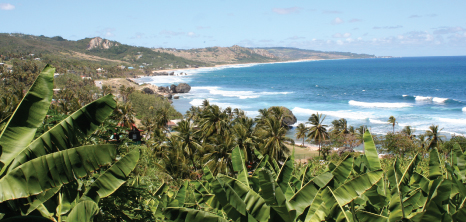|
Fruit TreesIn the horticultural world, fruit trees are deciduous trees that produce fruit which are used for human consumption.
In gardens and gullies all over Barbados, fruit trees can be found growing. The growth process of a fruit tree is an amazing one as the fruit of the fruit tree provides a protective shell for the seed while it matures. The seed gets its nutrients from the fruit. The seeds of these fruits are scattered by way of the many animals that assist with this process. The fruit tree needs to be pollinated in order to produce fruit. A bee or other such insect that feeds off the flower buds usually does this.
All across Barbados, fruit trees are very beneficial to home gardens and landscapes in general as they provide shade when its hot outside and shelter for many birds. Not to mention, the many benefits that are derived from the very fruit that these trees bear.
The Soil Conservation Unit in Barbados, grows all types of fruit trees that are sold as grafted trees. The process of grafting (method in which the tissues of one plant are encouraged to fuse with those of another) entails grafting the top section of the tree to the rootstock (a plant or stump which already has an established healthy root system that can be used for grafting a cutting or budding from another plant). The size of the tree is determined by the rootstock that was used.
Amidst the many fruit trees found on the island of Barbados, we've listed the following to give you a 'taste' of what the island has to offer and enjoy. There are as follows:- Ackee Tree, Avocado Tree, Banana/Fig/Plantain Tree, Barbados Cherry Tree, Breadfruit Tree, Carambola Tree, Coconut Tree, Dunks Tree, Fat Pork Tree, Golden Apple Tree, Grapefruit Tree, Mammee Apple Tree, Mango Tree, Passion Fruit Vine, Soursop Tree and Tamarind Tree.
Soil Conservation UnitThe Soil Conservation Unit was established in 1957 with its main function being to address the many special land conservation and stability problems occurring in the Scotland District of Barbados.
A variety of fruit trees are available at the Soil Conservation Unit including but not limited to Gooseberry, Pomegranate, Passion Fruit, Jamaican Ackee, Custard Apple, Soursop, Carambola, Guava and West Indian Cherry.
Further information on the Soil Conservation Unit can be sourced by contacting the Unit at telephone (246) 422-9030 or Email: scu@agriculture.gov.bb. When to Prune Fruit TreesPruning allows fruit trees trees to receive adequate sunlight that aids in the development of healthier and juicier fruit. It is advised that for the first two (2) years of the tree's life that the flowers and fruit are pruned. On the third (3rd) year of the fruit tree's life, it is quite fine to leave the flowers and fruit on.
Mature trees are also in need of pruning as this aids in giving life back and or prolonging the life of these trees. The pruning of these trees should be done in the dormant period.
Welchman Hall GullyWelchman Hall Gully is ¾ of a mile long and was once part of a plantation owned by a Welshman called General William Asygell Williams over 200 years ago. It was this man who first developed the gully with exotic trees and an orchard. Interestingly, the grapefruit tree is originally from Barbados and is rumoured to have started in Welchman Hall Gully.
Further information on the Welchman Hall Gully can be sourced at the following website http://www.welchmanhallgullybarbados.com/ or by contacting the Gully at telephone (246) 438-6671 or Email: dbranker@caribsurf.com.
|



